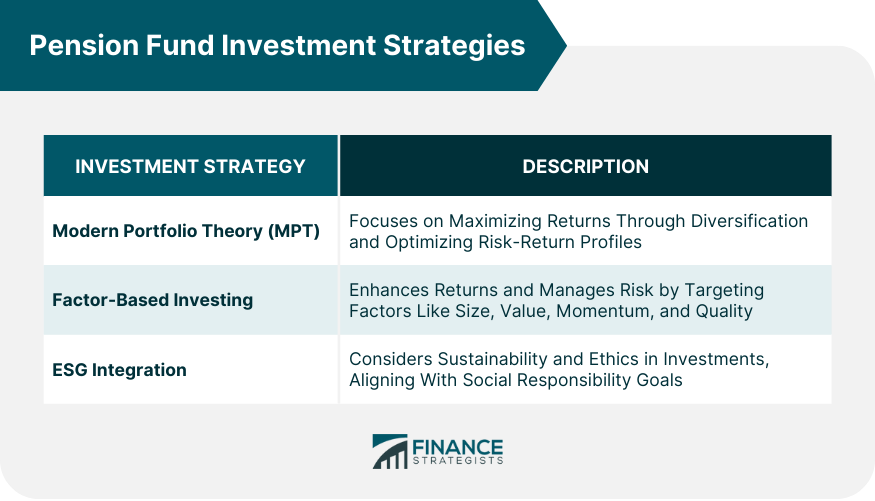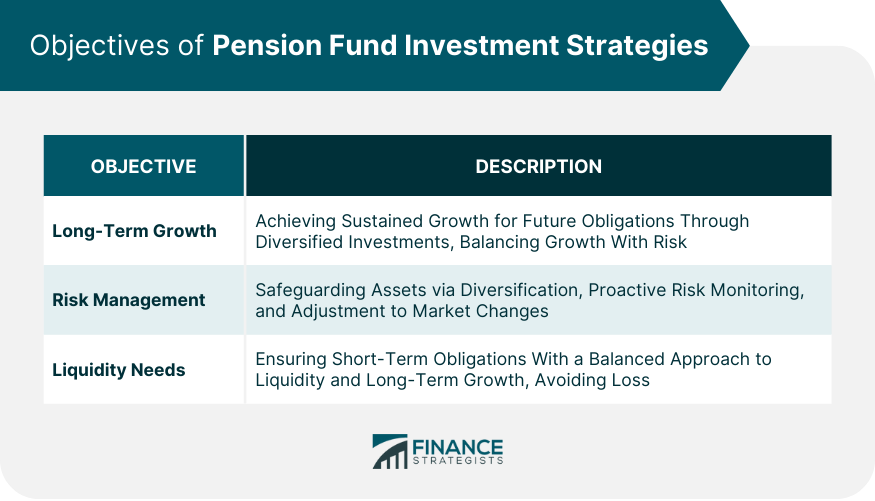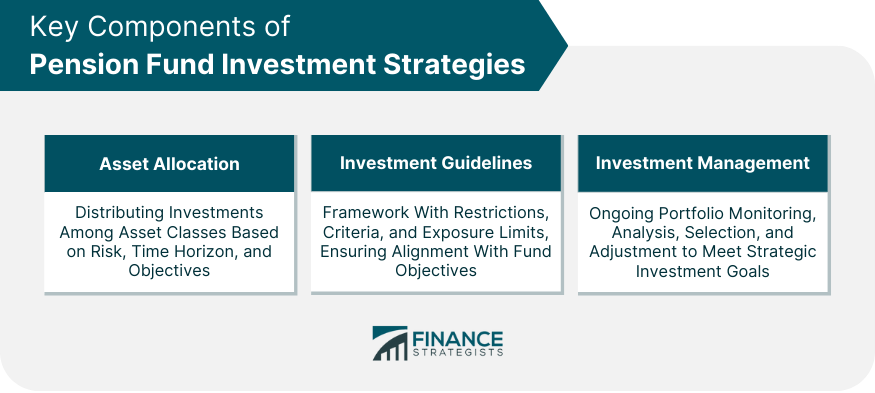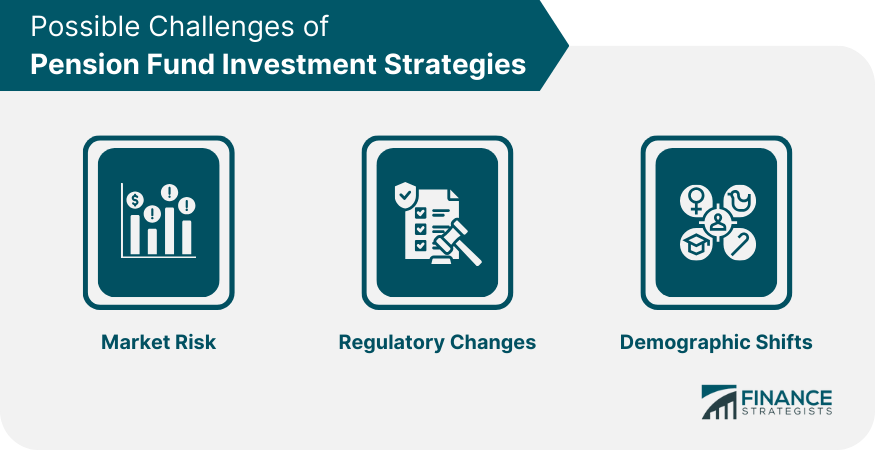Modern Portfolio Theory (MPT) plays a foundational role in pension fund investment. It focuses on maximizing return for a given level of risk through diversification. By combining various asset types, MPT aims to optimize the risk-return profile of the pension fund. This theory underscores the importance of an investment portfolio that is not overly reliant on any single asset or market. Factor-based investing is a strategy that seeks to enhance returns and manage risk by targeting specific drivers of return across asset classes. Factors such as size, value, momentum, and quality are considered in this approach. This method offers pension funds a framework for diversifying investments beyond traditional asset classes and geographical boundaries. Integrating Environmental, Social, and Governance (ESG) factors into investment decisions has become increasingly important. ESG integration involves considering the sustainability and ethical impact of investments. This approach not only aligns with the social responsibility mandates of many pension funds but also potentially mitigates long-term risks associated with environmental and governance issues. The cornerstone of a pension fund's investment strategy is achieving long-term growth. This growth is vital to ensure that the fund can meet its future obligations to beneficiaries. Investments are typically geared towards assets that offer potential for appreciation over time, such as stocks, real estate, and alternative investments. The challenge lies in balancing growth with risk, ensuring that the pursuit of returns does not expose the fund to undue volatility. In addition to traditional assets, innovation in investment approaches, like embracing technology-driven sectors or emerging markets, can contribute to growth. However, these decisions must be made with a deep understanding of market trends and a clear vision of the fund's long-term objectives. The aim is to build a portfolio that not only grows but also sustains and supports the retirees’ needs over decades. Risk management is crucial in safeguarding the assets of a pension fund. Diversification is a primary tool in this regard, spreading investments across various asset classes, industries, and geographies to mitigate potential losses. By not putting all eggs in one basket, pension funds can better withstand market downturns and economic uncertainties. Another aspect of risk management involves constant monitoring and adjusting of investment strategies in response to market changes. This dynamic approach allows pension funds to be proactive rather than reactive, adapting to new risks as they arise. Effective risk management ensures the stability and security of the fund, protecting the interests of its beneficiaries. Understanding and planning for liquidity needs is a critical objective for pension funds. Liquidity is essential for meeting the short-term obligations of the fund, especially in paying out benefits to retirees. This necessitates maintaining a portion of the portfolio in assets that can be readily converted to cash without significant losses. The balance between liquid assets and those aimed at long-term growth can be challenging. Too much liquidity can lead to lower returns, while too little can pose risks in meeting immediate cash needs. This balance requires careful planning and ongoing assessment to align with the fund’s payout schedules and other financial commitments. Asset allocation is the process of distributing investments among different asset classes, such as stocks, bonds, and real estate. The allocation is typically based on the fund's risk tolerance, investment horizon, and return objectives. Strategic asset allocation is crucial for balancing the growth potential against the risk profile of the pension fund. Investment guidelines are established to provide a framework for making investment decisions. These guidelines often include restrictions on certain types of investments, criteria for asset selection, and limits on exposure to specific sectors or geographies. They serve as a roadmap for fund managers, ensuring alignment with the fund's objectives and risk appetite. Investment management involves the ongoing process of monitoring, analyzing, and adjusting the investment portfolio. This includes selecting individual investments, rebalancing the portfolio, and responding to market changes. Effective investment management is vital for adapting to evolving market conditions while staying true to the strategic objectives of the pension fund. Market risk, or the risk of losses due to market fluctuations, is an inherent challenge in pension fund investment. Volatility in financial markets can significantly impact the value of investment portfolios. Navigating this risk requires a sophisticated understanding of market dynamics and a proactive approach to portfolio management. Regulatory changes can have a profound impact on pension fund investments. Changes in pension regulations, tax laws, or financial reporting standards can alter the investment landscape. Pension funds must remain agile and informed to adapt their strategies in response to regulatory shifts. Demographic shifts, such as aging populations and changing workforce dynamics, present long-term challenges for pension funds. These shifts can affect the ratio of contributors to beneficiaries, impacting the fund's cash flow and long-term sustainability. Addressing these demographic trends requires a forward-looking approach to investment strategy planning. Pension fund investment strategies are complex and multifaceted, requiring a deep understanding of various investment approaches and the ability to balance growth, risk, and liquidity. Modern Portfolio Theory, factor-based investing, and ESG integration are essential strategies that help pension funds optimize their risk-return profile and align with social responsibility mandates. The primary objectives of these strategies are to achieve long-term growth while managing risks and meeting liquidity needs effectively. Key components such as asset allocation, investment guidelines, and active investment management play a crucial role in achieving these objectives. However, pension funds must also navigate challenges like market volatility, regulatory changes, and demographic shifts. Addressing these aspects with a proactive and informed approach is vital for the stability and sustainability of pension fund investments, ensuring they can fulfill their obligations to beneficiaries for decades to come.Pension Fund Investment Strategies
Modern Portfolio Theory (MPT)
Factor-Based Investing
ESG (Environmental, Social, and Governance) Integration

Objectives of Pension Fund Investment Strategies
Long-Term Growth
Risk Management
Liquidity Needs

Key Components of Pension Fund Investment Strategies
Asset Allocation
Investment Guidelines
Investment Management

Possible Challenges of Pension Fund Investment Strategies
Market Risk
Regulatory Changes
Demographic Shifts

Bottom Line
Pension Fund Investment Strategy FAQs
Modern Portfolio Theory (MPT) is a strategy that aims to maximize returns for a given level of risk by diversifying investments across various asset types to optimize the risk-return profile of a pension fund.
Factor-based investing enhances returns and manages risk by targeting specific drivers of return like size, value, momentum, and quality across different asset classes, providing diversification beyond traditional investments.
ESG integration involves considering environmental, social, and governance factors in investment decisions, aligning with social responsibility mandates and potentially mitigating long-term risks associated with these factors.
The primary objectives of pension fund investment strategies are achieving long-term growth, effective risk management, and ensuring liquidity needs are met to support retiree benefits.
Challenges include market risk due to market fluctuations, regulatory changes affecting investments, and demographic shifts impacting cash flow and long-term sustainability. Proactive and informed strategies are essential to address these challenges.
True Tamplin is a published author, public speaker, CEO of UpDigital, and founder of Finance Strategists.
True is a Certified Educator in Personal Finance (CEPF®), author of The Handy Financial Ratios Guide, a member of the Society for Advancing Business Editing and Writing, contributes to his financial education site, Finance Strategists, and has spoken to various financial communities such as the CFA Institute, as well as university students like his Alma mater, Biola University, where he received a bachelor of science in business and data analytics.
To learn more about True, visit his personal website or view his author profiles on Amazon, Nasdaq and Forbes.















